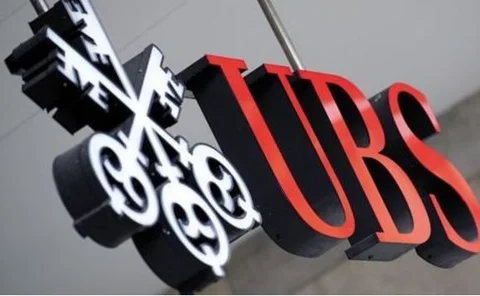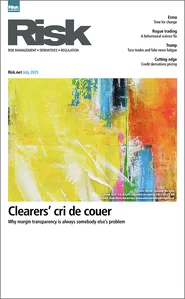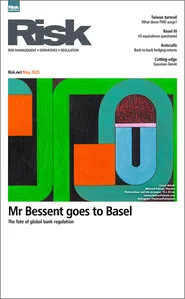Structured Products - Volume 6/No 8
Articles in this issue
Driving in reverse
Despite The Wall Street Journal lambasting equity-linked reverse convertibles as ‘dangerous investments’ and a chorus of bad press culminating in regulatory fines, the products continue to attract capital from the US retail sector. Joti Mangat asks how…
Trade of the month: Secondary pricing and fair value
As with any competitive market, fee levels are influenced to a large degree by the market, since a product cannot normally hide high fees and appear competitive.
Product review: Meteor's FTSE 100 kickout
Meteor is offering a standard kickout based on the top 10 UK stocks that promises a 17.5% annual return if eight of the stocks are above their initial level. The six-year product is issued by BNP Paribas and puts capital at risk if the three worst…
RBS and NAB offer investors the chance to restrike
Royal Bank of Scotland (RBS) and National Australian Bank (NAB) have teamed up to offer a product called Re-Strike, which will give investors with non-performing investments the chance to reset capital. RBS is the issuer.
Funds find favour
Funds are the structure of choice this year, as the exchange-traded funds business grows and structured product houses look for fund solutions. But the fund industry has its limitations, not least because of the complexity of structuring and the expense…
Balancing correlation
Credit Suisse is offering US investors a 5.5-year structured product that is based on a basket that is balanced by the inclusion of the iShares Barclays Tips Bond Fund ETF. As well as proving to have low volatility, the fund is not correlated to the…
FVC Custom Indexes
In Europe, the income index is the best performer over the past six years when compared with the accelerated and protected variants. Not so in Japan, where the accelerated index tops the trio of indexes as best performing. In both regions, the protected…
Barrier remains intact
The 50% barrier in the Investec Capital Protected FTSE 100 Income Plan 1 has remained in place since the launch of the product last year. Those opting for monthly or quarterly payments will have received their coupons, and the same looks likely for those…
Advisers Asset Management ahead of the game
US distributor Advisors Asset Management made the right call in choosing principal protection over reverse convertibles before the economic storm, and is now seeing a push towards equity, income and interest-rate products.
Rising to the technology challenge
The structured product market is staggering to its feet after the financial crisis dealt it a near fatal blow. Simple payout structures, shorter terms and capital protection kept the market alive, then investors looked to structures with payouts linked…
Doing it for the Kid
If someone could create a short form document of three or four pages that could alert retail investors to the proceeds and pitfalls of a structured product, then regulators could relax, investors could do their own simple risk-reward analysis and product…
Hybrid structures tempt investors
Volatile and uncertain markets have got investors thinking about diversified exposures to multiple asset classes both as yield generating opportunities and portfolio hedges. Hybrid structures, which blend discrete asset exposures into one pay-off, are…
Product performance
Based on the FTSE 100, this month FVC compares the virtues of three products structures common to the UK market that link to the FTSE 100
DnB Nor returns to the Norwegian structured products market
Nordic bank DnB Nor will resume distribution of structured products to high-net-worth investors and affluent retail clients in Norway on May 25. The two new products, translated roughly as “Global ‘Trigg’ (safe)” and “Top Norden” (top selected stocks…
Scrambling for yield
The rebound of credit markets in 2009 enabled product providers to decrease risk as well as offer higher yields to investors in the Americas, using techniques such as multipliers or digital payoffs. The result is an increase in the number of deals,…
UBS fines for misselling structured products could be first of many
UBS has come under fire in a series of court cases in the US for inappropriate sales of Lehman Brothers principal-protected notes and a failure to inform retail investors properly of the risks involved. More cases are likely.
Volatility fears increase after May whiplash
Equity markets suffered a whiplash effect before and after the second weekend of May, with the Eurostoxx 50 dropping 4.26% on Friday, May 7, only to bounce back by 10.35% the following Monday.
Structured Products Asia Awards 2010: Call for entries
The interviews for the annual Structured Products awards for Asia will start in August, with submissions in the categories below to be delivered to the editorial team by Monday July 19.
Increased volatility could help structure attractive returns
Widening bond spreads and market volatility will result in more interesting structured products, according to Morgan Stanley. The spikes in volatility that followed news of a hung parliament in the UK and the disagreements over a bail-out package for…
Barclays says kick-outs remain popular despite ISA confusion
Barclays Wealth says kick-out structures remain popular in the UK, despite the recent confusion over Individual Savings Accounts (ISAs) eligibility. Barclays is reissuing two kick-out structures to UK investors.
Editorial: ETFs are not derivatives
There are very few certainties in the financial markets, particularly when you are dealing in derivatives, but one truth that will always affect structured products is that exchange-traded funds (ETFs) are not derivatives. Newswires sometimes write…
S&P 500 index licensed to European ETF providers
Standard & Poor’s has opened its benchmark US index, the S&P 500, to seven exchange-traded fund (ETF) providers in Europe, meeting demand from a range of investors to be able to invest in US equities as the market recovers from recession.
FTSE targets UK pensions industry with defined contribution index
FTSE has created an index to help asset managers and retail investors navigate the pensions market. The index provider has partnered with London-based data services firm Pension DCisions to create the first benchmark for the UK’s defined contributions…
ETNs come to Finland with listing on the Nasdaq Helsinki
The Nordic market has been slower to pick up on the trend for exchange-traded products than its southern European counterparts but progress comes with Swedish bank Handelsbanken’s listing of Finland’s first exchange-traded notes (ETN) on the Nasdaq OMX…
Société Générale launches commodities ETN platform
As appetite for listed products and the transparency they offer increases, Société Générale (SG) has launched its first exchange-traded notes (ETN) on the London Stock Exchange, giving investors access to single commodities in a variety of currencies.
Markit ETP database provides tool to navigate market
The market for exchange-traded products (ETPs) is expanding as more products and issuers come to market, making it more difficult for asset managers and traders to make decisions about which ETFs to use.
Swiss exchange sees increase in structured product turnover
Turnover for structured products on the Swiss Scoach exchange is recovering after a dip in December last year, according to figures from the Swiss Structured Products Association. Volumes reached Sfr3.68 billion ($3.35 billion) in April 2010. Most of the…
Americas Report: Back from the breech
The structured products market in the US has been through some lows in the past year. The shock sometimes was so great that the lifeblood of the market, the reverse convertible, was withdrawn completely. It was pointless flogging a product that required…
Conservatism still reigns in wake of crisis
The private banking division of Credit Suisse is still seeing the impact of the financial crisis on its investors’ requirements. Fixed-income structured products remain popular but the low interest rate environment is still affecting the types of…
Half the loss
JP Morgan launched a two-year structured product based on property, homebuilding and financial institutions not long before the bankruptcy of Lehman Brothers. Capital was, of course, lost, but the cost would have been far greater on a direct investment
US investors still sensitive to counterparty risk
Counterparty risk remains a dominant theme for US investors, who are keen to analyse issuer credit ratings and credit default swap levels before buying a structured product. Richard Jory asks senior US industry figures how attitudes to counterparty…
Market snapshot
Tim Mortimer of Future Value Consultants reviews the product preferences in the US and UK structured products markets







































